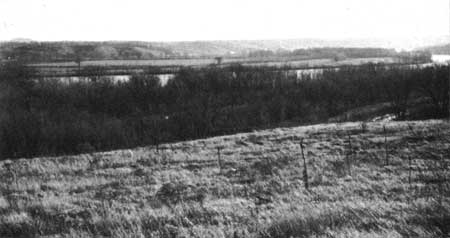|
SARATOGA National Historical Park |
 |

View looking east from the American river batteries, the key to the
American defensive position. It commanded the Hudson River and thus
blocked Burgoyne's advance.
The American Line
The two recent American victories greatly stimulated the hopes and efforts of the colonists. Men and supplies began to pour into Schuyler's tiny army which had now retreated as far south as Halfmoon. On August 19, just 3 days after the victory at Bennington, Maj. Gen. Horatio Gates replaced General Schuyler as the commander of the Northern Department. As the American Army increased in confidence and strength, growing from a low point of some 3,000 men, it began advancing slowly up the Hudson. Four miles from Stillwater, the British advance came upon the Americans, 9,000 strong, firmly entrenched at Bemis Heights under the command of Gates.
The American position was well chosen, for here the bluffs so converged with the river as to produce a narrow opening along the river plain through which a passage could be made only at great hazard. With a deep entrenchment blocking the river road, Thaddeus Kosciuszko, the Polish engineer and general who had volunteered in the American cause had lost no time in establishing a strong line of defense which in appearance was like the segment of a great circle. Powerful batteries extended along the edge of the bluff. From there the line turned northwestward and followed the natural advantages of the ground to a commanding knoll near the site of the Neilson barn where it then turned south by west, terminating at the edge of a ravine approximately three-quarters of a mile distant. The extremities of this position were defended by strong batteries. Most of the line was strengthened by a breastwork, without entrenchments, constructed from the trunks of felled trees, logs, and rails.
At the apex of the line, Neilson's barn was converted into a rude fort and a strong battery was established at this point. Running in front of the right wing of the American position, in a parallel direction, was a deep, heavily wooded ravine. The area immediately in front and to the west of the center of the American line, however, had been partially cleared, so that the felled trees made an abatis difficult to penetrate. Except for a small number of scattered farm clearings, the rough and rolling ground to the north of the American position was so thickly wooded as to furnish a distinct handicap to a coordinated attack or to the proper use of artillery.
Composition of the American Army
Behind the right wing of the American position were stationed the Continental brigades of Nixon, Paterson, and Glover under the immediate command of Gates. Behind the center and left were the Continental brigades of Poor and Learned; also the 500 Virginia riflemen and 300 Light Infantry of Major Dearborn, which together composed a corps led by Col. Daniel Morgan. Morgan's riflemen had been specially assigned by General Washington to the force confronting Burgoyne, as they were well versed in backwoods fighting and were calculated to offset the Indian and Tory allies of the British. The troops led by Poor, Learned, and Morgan constituted a division under the command of Arnold. Present with the American Army was an artillery train of 22 cannon. Thus stationed, and continuing to improve their fortifications, the American troops awaited the advance of Burgoyne.

|

| History | Links to the Past | National Park Service | Search | Contact |
|
Last Modified: Mon, Dec 2 2002 10:00:00 am PDT |

